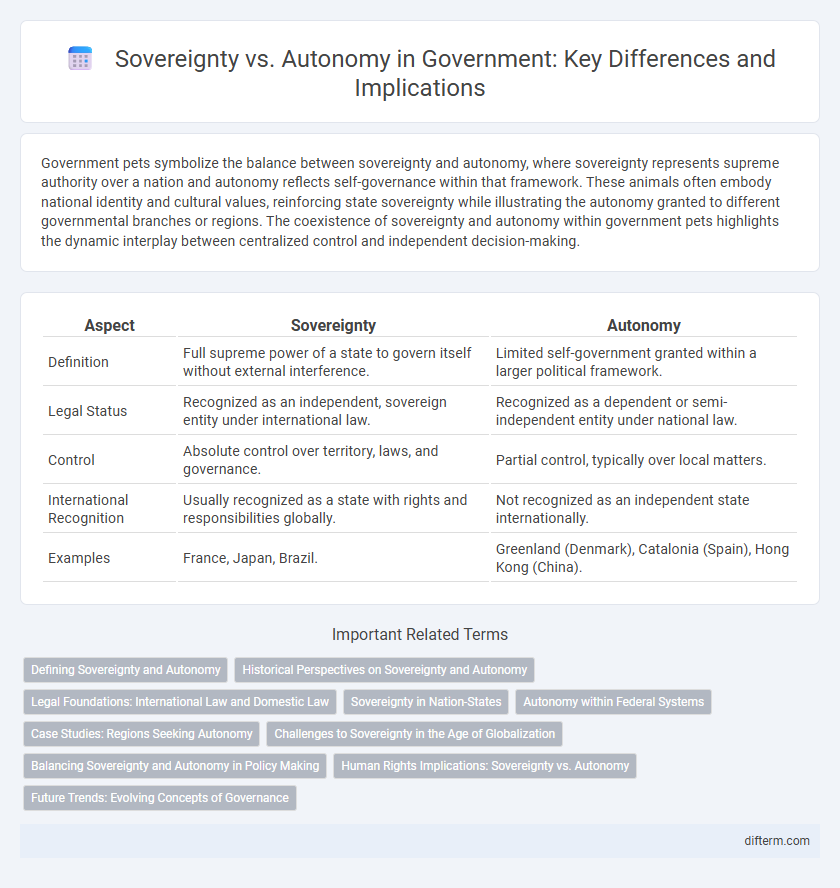Government pets symbolize the balance between sovereignty and autonomy, where sovereignty represents supreme authority over a nation and autonomy reflects self-governance within that framework. These animals often embody national identity and cultural values, reinforcing state sovereignty while illustrating the autonomy granted to different governmental branches or regions. The coexistence of sovereignty and autonomy within government pets highlights the dynamic interplay between centralized control and independent decision-making.
Table of Comparison
| Aspect | Sovereignty | Autonomy |
|---|---|---|
| Definition | Full supreme power of a state to govern itself without external interference. | Limited self-government granted within a larger political framework. |
| Legal Status | Recognized as an independent, sovereign entity under international law. | Recognized as a dependent or semi-independent entity under national law. |
| Control | Absolute control over territory, laws, and governance. | Partial control, typically over local matters. |
| International Recognition | Usually recognized as a state with rights and responsibilities globally. | Not recognized as an independent state internationally. |
| Examples | France, Japan, Brazil. | Greenland (Denmark), Catalonia (Spain), Hong Kong (China). |
Defining Sovereignty and Autonomy
Sovereignty refers to the supreme authority of a state to govern itself independently without external interference, encompassing legal and political control over its territory and population. Autonomy denotes the degree of self-governance granted to subnational entities or regions within a state, allowing them to exercise certain powers while remaining under the ultimate sovereignty of the central government. These concepts define the balance of power between national governments and regional administrations, shaping governance structures and territorial integrity.
Historical Perspectives on Sovereignty and Autonomy
Historical perspectives on sovereignty emphasize the central authority of a state to govern itself without external interference, a principle rooted in the Peace of Westphalia (1648). Autonomy, contrastingly, reflects the delegation of self-governing powers within a sovereign state, often granted to regions or communities to manage local affairs. These evolving concepts have shaped modern governance by balancing centralized control with decentralized administrative freedoms.
Legal Foundations: International Law and Domestic Law
Sovereignty in government is grounded in the principle of supreme authority recognized under international law, granting states full control over their territory and affairs without external interference. Autonomy, however, refers to the legal capacity of subnational entities or regions to govern themselves within the framework of domestic law, often protected by constitutional provisions. The interplay between sovereignty and autonomy is regulated by treaties, customary international law, and national constitutions, ensuring states uphold international obligations while allowing internal self-governance.
Sovereignty in Nation-States
Sovereignty in nation-states represents the absolute authority of a government to exercise control over its territory, laws, and policies without external interference. This concept is fundamental to international law, ensuring that each state has the right to govern independently, maintain territorial integrity, and conduct diplomatic relations. The recognition of sovereignty affirms a nation's political legitimacy and its ability to enforce laws within its borders.
Autonomy within Federal Systems
Autonomy within federal systems allows constituent states or provinces to exercise self-governance over local affairs while remaining subject to the overarching authority of the federal government. This decentralized approach balances the sovereignty of the nation with the diverse needs and identities of regional entities, promoting effective policy implementation and local participation. Legal frameworks and constitutional provisions delineate the extent of autonomous powers, ensuring coexistence without compromising national unity.
Case Studies: Regions Seeking Autonomy
Regions such as Catalonia in Spain and Scotland in the United Kingdom exemplify the complex interplay between sovereignty and autonomy, where demands for greater self-governance challenge central government authority. These case studies highlight how autonomy movements seek to preserve cultural identity and political control while operating within existing state sovereignty frameworks. The outcomes of these regional efforts often influence national policy reforms and international legal debates on self-determination.
Challenges to Sovereignty in the Age of Globalization
Globalization challenges traditional notions of sovereignty by increasing interdependence among states and diminishing exclusive governmental control over economic and political decisions. Transnational corporations, international organizations, and supranational entities often influence domestic policies, complicating the exercise of pure sovereignty. Cybersecurity threats, migration flows, and global environmental issues further strain state sovereignty, demanding a balance between national autonomy and international cooperation.
Balancing Sovereignty and Autonomy in Policy Making
Balancing sovereignty and autonomy in policy making requires governments to navigate the tension between maintaining national control and granting sub-national entities self-governance. Effective frameworks foster decentralized decision-making while upholding the state's ultimate authority, enabling tailored local policies that reflect diverse regional needs. This dynamic equilibrium enhances political stability, preserves cultural identity, and optimizes resource management within the sovereign territory.
Human Rights Implications: Sovereignty vs. Autonomy
Sovereignty asserts a state's supreme authority within its territorial boundaries, often limiting external interference but can risk overlooking universal human rights standards. Autonomy grants regions self-governance that allows tailored human rights protections yet may result in inconsistent enforcement across different jurisdictions. Balancing sovereignty and autonomy requires legal frameworks that uphold fundamental human rights while respecting the political independence of states and subnational entities.
Future Trends: Evolving Concepts of Governance
Sovereignty and autonomy are being redefined as governments adapt to increasing global interdependence and technological advancements, prompting new governance models that balance national control with regional self-management. Emerging trends emphasize collaborative frameworks where sovereignty is exercised through shared authority, enhancing local autonomy while maintaining national unity. Future governance will likely prioritize flexible structures that integrate digital sovereignty and decentralized decision-making to address complex global challenges.
sovereignty vs autonomy Infographic

 difterm.com
difterm.com